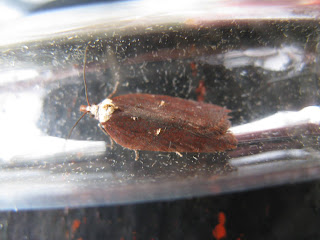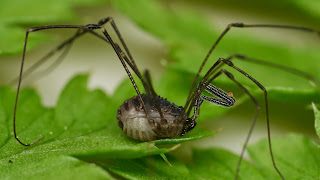Wednesday 1st December 2021, Kinsley Wood near Knighton
Knighton is a long way from most of our homes (it is even further when the road is closed and a lengthy diversion in place), but that did not put off 10 hardy souls from making the trip.The day was “fresh” to put it politely, i.e. very cold and windy but what should we have expected? We were at the top of a hill approaching 1000ft in height in December. It must be said that we did have quite a reasonable amount of sun but also, a first for a few weeks, showers of rain.
Our start was delayed due to the diversion but we were soon into our stride. Perhaps “stride” is not the correct word to use as “striding” is something we do not really do, apart from when we are keen to get back to the cars – perhaps shuffled would better describe our mode of movement.
An early sighting was a Larch ladybird.
 |
| Photograph: David Williams |
This ladybird’s scientific name is Aphidecta obliterata. Please feel sorry for any aphid in its path.
The strong winds of Storm Arwen had caused some damage and we were treated to several fallen conifer branches and uprooted Scot’s pine. And yes, “treated” is an appropriate word as it gave us a chance to look for invertebrates that inhabit the canopy and are normally well out of our reach.
And it worked! We were rewarded with the sight of a Striped ladybird.
 |
| Photograph: David Williams |
This ladybird species is normally the inhabitant of “Mature” conifers, mainly Scot’s Pine, i.e trees that you can only dream of reaching the top. There are very few records of this species in Shropshire so this was an excellent find and worthy of another photograph!
 |
| Photograph: David Williams |
There were some tall gangly trees on the side of a steep slope which were youngish oaks that had, through competition for light, grown tall quickly. In amongst the trunks we found some islands of Polytrichum and other mosses poking through the extensive litter of dropped oak leaves.
A couple of patches were vacuumed and …
Hey Presto!
A male snow flea was found, made to look menacing in this excellent photograph.
 |
| Photograph: David Williams |
We continued to shuffle our way through the site eventually reaching the summit. In celebration we had lunch.
Here are some of our other encounters during this period:
A beetle larva – we have no idea which species;
 |
| Photograph: David Williams |
A staphylinid beetle, Anthobium atrocephalum;
 |
| Photograph: Nigel Cane-Honeysett |
An Oak cherry gal caused by the gall wasp Cynips quercusfolii;
 |
| Photograph: Stephen Mitchell |
A collection of the fungus Psathyrella piluliformis, Common Stump Brittlestem;
 |
| Photograph: John Bingham |
And one to whet the appetite, a beetle Dromius quadrimaculatus that has succumbed to a fungus.
 |
| Photograph: Nigel Cane-Honeysett |
Lunch started in warm(ish) sun and ended in a passing shower of very cold rain.
At this point our Arachnologist unveiled one of his latest gadgets – A battery powered hair dryer!
A hair dryer on top of a hill????
There was method in his madness ... hair dryers produce warm air – which was used generously to warm up hands.
What a wonderful idea.
From the summit it was downhill all the way to the cars. We did stop and investigate the vegetation every now and then finding amongst other things:
A moth, Acleris hastiana;
 |
| Photograph: Stephen Mitchell |
A ground bug, Drymus brunneus;
 |
| Photograph: Nigel Cane-Honeysett |
A harvestman, Platybunus triangularis;
 |
| Photograph: David Williams |
Another staphylinid beetle, Xantholinus linearis;
 |
| Photograph: Nigel cane-Honeysett |
And a Lemon slug.
 |
| Photograph: John Bingham |
This was an excellent find as Lemon slugs are quite rare. They are found in ancient woodland which this wood used to be before being used as a conifer plantation.
The temperature was dropping and the clouds were getting darker and more threatening. As we left the site with the rain started and fell heavily and relentlessly for most of the journey home.
To finish, this week’s choice for Wednesday Weevil of the Week was rather limited as very few were found and they were all turned out to be the same species Sitona lineatus.
 |
| Photograph: Emm Cane-Honeysett |
Our weevil enthusiast points out that this is much smaller and darker than normal. Here is an example of the usual colouring also found in the wood.
 |
| Photograph: Emm Cane-Honeysett |
Wednesday, 8th December 2022, Harton Hollow
Postponed due to the remnants of Storm Barra.Wednesday, 15th December 2022, Whitcliffe Wood, Ludlow.
We had to practise all our car parking skills when we met in the car park of Whitcliffe Wood, just west of Whitcliffe Common in Ludlow, as the rest of Ludlow seemed to have decided to visit the wood on the same day. Fortunately the parking issues were solved quickly when one car left creating the space we needed.
The first area of interest that we investigated was what looked like a sunken lane. The vegetation provided us with the first patches of Polytrichum moss of the day which was vigorously searched for snow fleas.
Without success!
But we did find the flightless female Mottled umber moth.
 |
| Photograph: David Williams |
We moved on and passed a few promising areas of snow flea habitat which were searched and again were found to be flealess.
This brought us to a clearing that was dominated by birch scrub and under the scrub there were extensive patches of our favourite moss.
Extensive use of our vacuum samplers yielded a result.
No, not a snow flea, but a harvestman Mitostoma chrysomelas.
 |
| Photograph: David Williams |
This find transported our arachnologist to harvestman utopia.
Why?
This is a harvestman that is rarely found in Shropshire (although one did turn up in his garden).
A particular attribute is the heavily “dewed” pedipalps which are used to gather its prey such as springtails. And a closer examination of this creature's pedipalps revealed this process in action.
 |
| Photograph: David Williams |
Interest in this clearing was maintained for a long time, so long, in fact, that we paused in the middle for lunch. This interest was intensified by the fact that we found a snow flea, not in the large patches under the birch scrub, but on moss on a bank at the side of the path.
Other finds in the clearing included:
Ypsolopha ustella;
 |
| Photograph: Stephen Mitchell |
And a staphylinid beetle, Othius subuliformis.
 |
| Photograph: John Bingham |
Having spent so long in the clearing and being fearful of straying into Herefordshire (indeed there was a bit of a debate about whether the clearing was in that county - we were not), we decided to meander our way back to the cars.
Once again the “sunken lane” drew our attention as it and its banks provided a variety of habitats from lush vegetation for the time of year through mossy areas, fallen trees to bare rock.
Discoveries included:
Another Mottled umber moth but this time a male;
 |
| Photograph: Stephen Mitchell |
A Purple clay moth larva;
 |
| Photograph: John Bingham |
A spider, Anelosimus vittatus;
 |
| Photograph: John Bingham |
And a beetle, Loricia pilicornis.
 |
| Photograph: John Bingham |
And to crown the day we were treated to one of our photographers sacrificing his body and clothing to get in the optimum position to take a photograph of a collection of Milking bonnets.
 |
| Photograph: Bob Kemp |
Our WWWWW – Whitcliffe Wood Wednesday Weevil of the Week - was Ceutorhynchus typhae.
 |
| Photograph: Emm Cane-Honeysett |
My thanks to Forestry England for giving us permission to do what we enjoy doing and to the photographers for providing the photographs that illuminate this report.
Festive Greetings
The creative juices of some of the group were put to good use over the Christmas period:
 |
| "Photograph": Stephen Mtchell |
 |
| "Photograph": Emm Cane-Honeysett |
 |
| "Photograph": Stephen Mitchell |
And Finally
Where's Wally?
(Use your browser tools to view a larger image, e.g. in Microsoft Edge you can just click on the image to display all the images in the blog, or right click and select open link in new tab.)





















